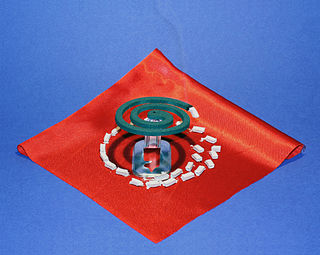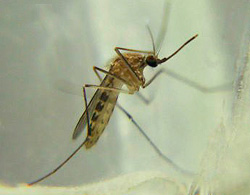| Macrocyclops albidus | |
|---|---|
 | |
| Scientific classification | |
| Kingdom: | |
| Phylum: | |
| Subphylum: | |
| Class: | |
| Subclass: | |
| Order: | |
| Family: | |
| Genus: | |
| Species: | M. albidus |
| Binomial name | |
| Macrocyclops albidus | |
Macrocyclops albidus is a larvivorous copepod species.
| Macrocyclops albidus | |
|---|---|
 | |
| Scientific classification | |
| Kingdom: | |
| Phylum: | |
| Subphylum: | |
| Class: | |
| Subclass: | |
| Order: | |
| Family: | |
| Genus: | |
| Species: | M. albidus |
| Binomial name | |
| Macrocyclops albidus | |
Macrocyclops albidus is a larvivorous copepod species.
It makes its habitat in still fresh waters such as in residential roadside ditches, pools, ponds, and other environments with sufficient food supply.
Macrocyclopsis feed on mosquito larvae. Macrocyclops albidus has proven highly efficient in controlling mosquitoes, reaching close to 90% reduction in larval survival under field conditions and exceeding the recommended predation rates for effective mosquito control in laboratory experiments. [2] In laboratory studies, the common Macrocyclopsis killed an average of 27 first-instar Culex quinquefasciatus larvae/copepod/day. [3]
Macrocyclops albidus is a known intermediate host for the hermaphroditic parasite Schistocephalus solidus , a tapeworm of fish and fish-eating birds.
Macrocyclops is a member of Crustacea: Copepoda. The genus Macrocyclops is characterized by a fifth leg of two distinct segments, the distal segment bearing three spines or setae on its terminal end. [4] Macrocyclops albidus is distinguished by the bare medial surface of the caudal rami and the hyaline membrane on the last segment of the antennule, which is smooth or finely serrated. [4]

Rift Valley fever (RVF) is a viral disease of humans and livestock that can cause mild to severe symptoms. The mild symptoms may include: fever, muscle pains, and headaches which often last for up to a week. The severe symptoms may include: loss of sight beginning three weeks after the infection, infections of the brain causing severe headaches and confusion, and bleeding together with liver problems which may occur within the first few days. Those who have bleeding have a chance of death as high as 50%.

Mosquitoes are members of a group of almost 3,600 species of small flies within the family Culicidae. The word "mosquito" is Spanish and Portuguese for "little fly". Mosquitoes have a slender segmented body, one pair of wings, one pair of halteres, three pairs of long hair-like legs, and elongated mouthparts.

Copepods are a group of small crustaceans found in nearly every freshwater and saltwater habitat. Some species are planktonic, some are benthic, a number of species have parasitic phases, and some continental species may live in limnoterrestrial habitats and other wet terrestrial places, such as swamps, under leaf fall in wet forests, bogs, springs, ephemeral ponds, and puddles, damp moss, or water-filled recesses (phytotelmata) of plants such as bromeliads and pitcher plants. Many live underground in marine and freshwater caves, sinkholes, or stream beds. Copepods are sometimes used as biodiversity indicators.

An insect repellent is a substance applied to skin, clothing, or other surfaces to discourage insects from landing or climbing on that surface. Insect repellents help prevent and control the outbreak of insect-borne diseases such as malaria, Lyme disease, dengue fever, bubonic plague, river blindness, and West Nile fever. Pest animals commonly serving as vectors for disease include insects such as flea, fly, and mosquito; and ticks (arachnids).

Mosquito control manages the population of mosquitoes to reduce their damage to human health, economies, and enjoyment. Mosquito control is a vital public-health practice throughout the world and especially in the tropics because mosquitoes spread many diseases, such as malaria and the Zika virus.

Culex is a genus of mosquitoes, several species of which serve as vectors of one or more important diseases of birds, humans, and other animals. The diseases they vector include arbovirus infections such as West Nile virus, Japanese encephalitis, or St. Louis encephalitis, but also filariasis and avian malaria. They occur worldwide except for the extreme northern parts of the temperate zone, and are the most common form of mosquito encountered in some major U.S. cities, such as Los Angeles.
Culex (Culex) tritaeniorhynchus is a species of mosquito and is the main vector of the disease Japanese encephalitis. This mosquito is a native of northern Asia, and parts of Africa. Females target large animals for blood extraction, including cattle and swine, and are strongly anthropophilic.
Lysinibacillus sphaericus is a Gram-positive, mesophilic, rod-shaped bacterium commonly found on soil. It can form resistant endospores that are tolerant to high temperatures, chemicals and ultraviolet light and can remain viable for long periods of time. It is of particular interest to the World Health Organization due to the larvicide effect of some strains against two mosquito genera, more effective than Bacillus thuringiensis, frequently used as a biological pest control. L. sphaericus cells in a vegetative state are also effective against Aedes aegypti larvae, an important vector of yellow fever and dengue viruses.

Culex pipiens, commonly referred to as the common house mosquito, is a species of mosquito. House mosquitoes are some of the most common mosquitoes in the United States. More specifically, Culex pipiens is considered as the northern house mosquito, as it is the most common mosquito to the northern regions of the US. North of the 39th parallel north in the US, only C. pipiens are present, whereas south of the 36th parallel north, only C. quinquefasciatus are present. Additionally, they can be found in both urban and suburban temperate and tropical regions across the world.
Robert Gurney was a British zoologist from the Gurney family, most famous for his monographs on British Freshwater Copepoda (1931–1933) and the Larvae of Decapod Crustacea (1942). He was not affiliated with any institution, but worked at home, initially in Norfolk, and later near Oxford. He travelled to North Africa and Bermuda, and received material from other foreign expeditions, including the Terra Nova Expedition (1910–1913) and the Discovery Investigations of the 1920s and 1930s.
Rocio viral encephalitis is an epidemic flaviviral disease of humans first observed in São Paulo State, Brazil, in 1975. Low-level enzootic transmission is likely continuing in the epidemic zone, and with increased deforestation and population expansion, additional epidemics caused by Rocio virus are highly probable. If migratory species of birds are, or become involved in, the virus transmission cycle, the competency of a wide variety of mosquito species for transmitting Rocio virus experimentally suggest that the virus may become more widely distributed. The encephalitis outbreak in the western hemisphere caused by West Nile virus, a related flavivirus, highlights the potential for arboviruses to cause severe problems far from their source enzootic foci.

Crustaceans may pass through a number of larval and immature stages between hatching from their eggs and reaching their adult form. Each of the stages is separated by a moult, in which the hard exoskeleton is shed to allow the animal to grow. The larvae of crustaceans often bear little resemblance to the adult, and there are still cases where it is not known what larvae will grow into what adults. This is especially true of crustaceans which live as benthic adults, more-so than where the larvae are planktonic, and thereby easily caught.

Culex quinquefasciatus, commonly known as the southern house mosquito, is a medium-sized mosquito found in tropical and subtropical regions of the world. It is a vector of Wuchereria bancrofti, avian malaria, and arboviruses including St. Louis encephalitis virus, Western equine encephalitis virus, Zika virus and West Nile virus. It is taxonomically regarded as a member of the Culex pipiens species complex. Its genome was sequenced in 2010, and was shown to have 18,883 protein-coding genes.
Pylore Krishnaier Rajagopalan is an Indian vector control scientist, biologist and acarologist, known for his pioneering contributions to the control programmes against vector-borne diseases in India.[1] He is a former director of the Indian Council of Medical Research managed Vector Control Research Centre, Pondicherry.[2][3] He graduated in 1949 from the Banaras Hindu University and obtained a Masters in Zoology with University First Rank there itself in 1951. In 1952 he joined the fledgling Virus Research Centre in Pune, and worked under the supervision of some of the finest vector control specialists such as Dr T Ramachandra Rao. In recognition of his outstanding work as a young research scientist, in 1957 he was awarded a Fellowship by the Rockefeller Foundation to pursue a Master's program in Public Health from the University of California.[4] He went on to secure a Diploma in Acarology from the University of Maryland at College Park.
Mesocyclops aspericornis is a freshwater copepod species in the genus Mesocyclops found in the tropics. It was collected from Sumatra, Singapore and Hawaii.
Lutzia fuscana is a mosquito that is predatory in its larval stages. It has been investigated as a possible biological control agent, showing some promise where vector species share limited or specific breeding habitat.
Culex (Culex) pseudovishnui is a species complex of mosquito belonging to the Culex vishnui group of the genus Culex. It is found in Bangladesh, Cambodia, China, Hong Kong, India, Indonesia, Iran, Iraq, Japan, South Korea, Laos, Macau, Malaysia, Nepal, New Guinea (Island); Papua New Guinea, Pakistan, Philippines, Singapore, Sri Lanka, Thailand, Taiwan and Vietnam. It is a major vector of West Nile virus, and Japanese encephalitis virus Larvae can be found from the edges of rice fields. Adults can bite vertebrates from both indoor and outdoor places with a peak biting time on 7pm onwards.

Culex nigripalpus is a species of medium-sized, dark, blood-feeding mosquito of the family Culicidae.
Longipedia is a genus of marine copepods of the family Longipediidae, order Canuelloida.
Mesocyclops longisetus is a species of freshwater copepod in the family Cyclopidae. Two subspecies are accepted, Mesocyclops longisetus curvatus Dussart, 1987, and Mesocyclops longisetus longisetus. It has a neotropical distribution.